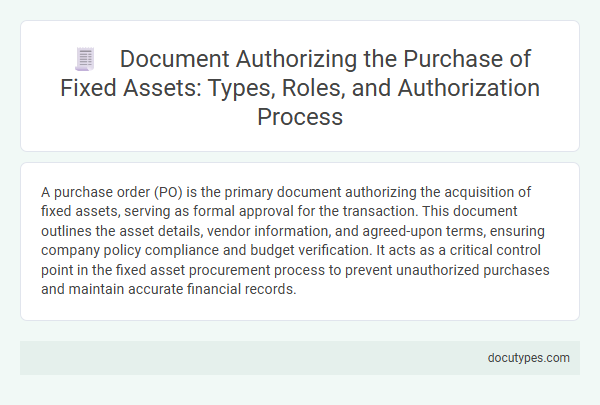A purchase order (PO) is the primary document authorizing the acquisition of fixed assets, serving as formal approval for the transaction. This document outlines the asset details, vendor information, and agreed-upon terms, ensuring company policy compliance and budget verification. It acts as a critical control point in the fixed asset procurement process to prevent unauthorized purchases and maintain accurate financial records.
Introduction to Document Authorization for Fixed Asset Purchases
Authorization to purchase fixed assets typically requires a formal document known as a purchase order or capital expenditure approval form. This document ensures that the acquisition aligns with company policies, budget constraints, and asset management strategies. You must obtain proper authorization before proceeding to maintain financial control and compliance.
Importance of Authorization in Fixed Asset Acquisition
The document that authorizes the purchase of fixed assets is typically a purchase requisition or a purchase order, depending on the organization's procurement process. This formal document ensures that the acquisition aligns with budgetary approval and organizational policies.
Authorization in fixed asset acquisition is crucial as it prevents unauthorized expenditures and supports financial control. Proper authorization helps maintain accurate asset records and ensures compliance with internal controls and regulatory requirements. It also facilitates accountability by clearly defining the approval chain for significant capital investments.
Common Types of Authorization Documents for Fixed Assets
The document that authorizes the purchase of fixed assets is essential for financial control and accountability. You need proper authorization to ensure purchases comply with company policies and budget limits.
- Purchase Requisition - This internal document initiates the request to acquire fixed assets and requires approval from department heads.
- Purchase Order (PO) - A formal contract issued to vendors that confirms the authorized purchase of specific fixed assets with agreed terms.
- Capital Expenditure Approval - Management or board-level authorization that confirms the expense aligns with strategic investment plans and financial policies.
Key Roles Involved in the Authorization Process
The document that authorizes the purchase of fixed assets is typically a purchase requisition or purchase order approved by management. This document serves as formal approval, ensuring the acquisition aligns with the company's budget and policies.
Key roles involved in the authorization process include the department manager who identifies the need and initiates the request. The finance team evaluates the budget impact, while senior management or the procurement officer provides final approval to confirm compliance with financial controls.
Step-by-Step Authorization Workflow for Fixed Asset Purchases
What document authorizes the purchase of fixed assets? A Purchase Requisition form typically initiates the authorization process for acquiring fixed assets. This document outlines the asset details, justification, and estimated cost for managerial approval.
What are the steps in the authorization workflow for fixed asset purchases? The workflow starts with submitting the Purchase Requisition to the department head for review. After approval, the requisition moves to the finance department for budget verification before final authorization by senior management.
How does the Purchase Order fit into the fixed asset purchase authorization? Once the Purchase Requisition is approved, a Purchase Order is generated authorizing the vendor to supply the fixed asset. The Purchase Order serves as a formal contract confirming the purchase terms and approval status.
What role does budget approval play in authorizing fixed asset purchases? Budget approval confirms that funds are available and allocated for the acquisition of the fixed asset. This step prevents overspending and ensures alignment with the company's financial plan.
What final documentation completes the fixed asset purchase authorization? After the asset is ordered and received, asset tagging and recording in the fixed asset register finalize the authorization process. These documents support asset tracking, depreciation scheduling, and audit compliance.
Essential Information Included in Fixed Asset Authorization Documents
| Document Type | Essential Information Included | Purpose |
|---|---|---|
| Fixed Asset Purchase Authorization Form |
|
Serves as formal approval for acquiring fixed assets, ensuring compliance with company policies and budget constraints. |
| Purchase Order (PO) |
|
Acts as a legally binding agreement to purchase the asset from the vendor. |
| Capital Expenditure Request |
|
Justifies the need for purchasing fixed assets, guiding high-level authorization decisions. |
Internal Controls and Compliance in Asset Purchase Authorization
The document authorizing the purchase of fixed assets is typically a Purchase Requisition or Purchase Order, which ensures proper Internal Controls and Compliance. This document verifies that the asset purchase adheres to company policies and regulatory requirements.
- Purchase Requisition - An internal document requesting approval for the acquisition of fixed assets, enabling budget verification and management oversight.
- Purchase Order - A formal contract issued to vendors authorizing the purchase, providing audit trails essential for compliance.
- Authorization Workflow - A defined approval process involving multiple stakeholders to ensure accountability and prevent unauthorized asset acquisitions.
Digital vs. Manual Authorization Methods
The document that authorizes the purchase of fixed assets is typically a Purchase Order (PO) or an asset acquisition approval form. Your choice between digital and manual authorization methods significantly impacts the efficiency and security of this process.
- Manual Authorization - Requires physical signatures and paper documentation, often resulting in slower processing times.
- Digital Authorization - Utilizes electronic signatures and digital workflows, enhancing speed and traceability.
- Compliance and Security - Digital methods offer improved audit trails and reduce the risk of unauthorized purchases compared to manual paper-based authorization.
Choosing a digital authorization method streamlines fixed asset purchases while maintaining compliance and control over your assets.
Challenges and Best Practices in Authorizing Fixed Asset Purchases
The primary document that authorizes the purchase of fixed assets is the purchase order, which outlines the asset details, approval, and budget allocation. Challenges include ensuring proper approval workflows, preventing unauthorized purchases, and maintaining accurate records. Best practices involve implementing standardized approval processes, regular audits, and clear communication between departments to safeguard your organization's assets.
What Document Authorizes the Purchase of Fixed Assets? Infographic

